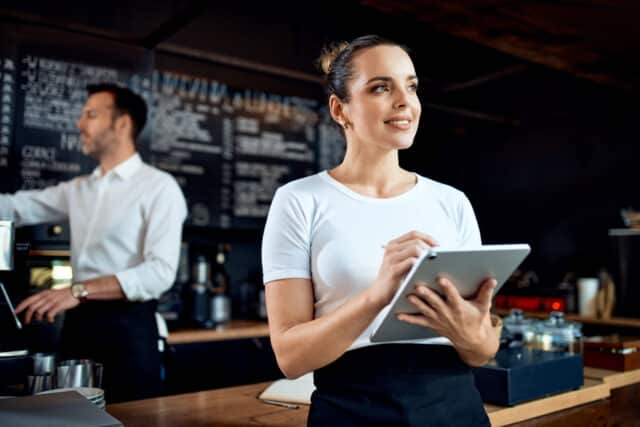
With the recent talent shortage crisis, retaining talent is important. Workforce planning can make all the difference when it comes to meeting your current business goals and retaining great employees for the long haul. Effective workforce management is a key component of successful business across a wide range of different sectors.
Modern advancements like workforce management software can help streamline the process and give employers better control over their operations, but it’s still important to have a working understanding of the concept and its considerations.

What is workforce planning?
Workforce planning, also known as strategic workforce or HR planning, is a process that allows businesses to review the skills and needs of their staff on an ongoing basis. Generally, it sets out to identify and use a company’s existing pool of skilled workers to the best of its abilities to achieve both immediate and long-term business goals. It can be put into practice in a variety of different ways.
It’s essential for business leaders to have a fixed workforce planning strategy in place. Ideally, this should be as comprehensive as possible, covering the recruitment process, factoring in training and development, and aiming to pair employees with tasks best suited to their working styles, skill sets, and career goals.
Risk mitigation with a workforce plan
Workforce planning also involves a fair amount of preparation for some worst-case scenarios. It’s of paramount importance to use data related to productivity, attrition rates or staff churn, time-to-hire, and cost of vacancy. This is where a reputable workforce management strategy shines.
The goal is to stay on top of employee relations and spot strategic gaps related to reducing labor costs and improving outputs, as well as looking at avenues to help employees strike a healthier work-life balance.
Strategic workforce planning process
Implementing workforce planning is not a one-size-fits-all process, and it’ll take some experimentation to find the right mix of elements for your business. Because it’s an ongoing process that will adapt according to the changing needs of the business, it’s important to take steps to identify current and potential future talent gaps through a workforce gap analysis.
Performing a workforce gap analysis
To identify and anticipate workforce gaps, it’s vital to understand the company’s current workforce, company needs, and how that could change in the future. Here’s how to perform a workforce gap analysis:
- Identify current workforce capabilities: Gather as much information as possible about the various departments of your workforce. This includes asking department heads about what they need to meet their targets.
- Identify skill gaps: Assess the needs of each department. Then take a look at current staff and see if there are any areas where current needs aren’t being met. From there, determine if the gap can be best resolved through training or hiring additional staff.
- Identify other gaps: Examine the existing workplace profile holistically, spotting any gaps, such as a high turnover rate, that may signal a bigger problem related to company culture.
- Create a plan for action: Devise an action plan for how you’ll go about fixing these problems. At this stage, having access to real-time reporting could be especially useful.
Actively monitor the plan after it’s been implemented so you can make revisions as things unfold. Additionally, monitor industry trends and keep close tabs on each department to anticipate future needs and address them before they become a problem.
What are the benefits of workforce planning?
Workforce planning has a multitude of benefits, including letting employers keep a close eye on staffing requirements at all times. This improves the efficiency of the recruitment process, while potentially cutting costs simultaneously. It also has many industry-specific benefits.
The current state of the recruitment market has been driven by candidates’ sense that they aren’t sufficiently valued. From jumping through interview hoops to waiting weeks to hear back about a role, “The Great Resignation” has highlighted the systemic power imbalance between employers and employees in the historically employer-driven market. Businesses must address this fact head-on, and introduce a far more personalized and human approach to recruitment.
Workforce planning examples from different industries
While workforce planning is important in nearly every industry, each field offers specific challenges that must be considered. For example, companies in the hospitality industry have different needs to meet than those in retail or healthcare. Recognizing these needs often requires a deep understanding of the field.
Workforce planning in the hospitality industry
According to the AHLA survey, over 63% of companies in the hospitality industry report being severely understaffed. Finding a reliable source of workers is a constant need for this sector.

Now that things are returning to a state resembling normalcy in the wake of COVID-19, the hospitality industry will be keener than ever to get the most out of the employees who remain on their payroll. Workforce planning can help with this.
The process will help in more ways than one. Due to a rise in general unemployment rates, businesses in the sector are experiencing the effects of the Great Reshuffle, so they’ll need to adjust their workforce model to align with current job seeker priorities. Investing in the right workforce planning software can make it much easier for hiring managers to flesh out the best candidate pool when it’s time to create an interview shortlist.
Workforce management in the retail industry

Retailers have had to think on their feet during each lockdown we’ve faced. Those who already had workforce planning in place likely found it easier to spread skills around based on unforeseen changing needs. Businesses in the retail sector that haven’t done so already now have a great opportunity to streamline their workforce in a way that helps them maximize their output. Forget about having to waste more time than necessary with scheduling and payroll processes — the best employer services can take care of the nitty-gritty, leaving managers with more time to focus on big-picture challenges instead.
Workforce planning in the healthcare sector
Finding a reliable stream of trained staff — each using their skills to drive the entire business forward — is essential in the healthcare sector. Although capacity challenges are somewhat the norm, the industry still needs to remain flexible to manage the ever-present dramatic shifts taking place in the sector. For example, this need for flexibility has seen an increase in the popularity of travel nurses, or skilled nurses who have the ability to choose their desired shifts and work patterns.

Temporary staffing platforms are entering this segment to deliver the preferences of this high-demand workforce. Devising a good strategy will separate more essential and less essential roles and will always ensure a steady stream of new staff over time.
Workforce planning in facilities management and the industrial sector
Workforce planning can assist in addressing the mounting skills shortage within the industrial sector. Because new practices are emerging all the time, it can be difficult for managers to know exactly how to go about finding the best skills for current and future projects.

In the facilities management industry, there has been a growing demand for managers with strong data integration skills. A workforce planning system can make recruitment a key part of the broader company strategy, and help factor in skilled new workers going forward. This can mean the difference between long-term survival or being pushed out of the market by a company with a better plan in place.
Devising and implementing a workforce plan is a good way for companies in any industry to stay competitive, offer attractive opportunities for prospective workers, and stay prepared for future changes in shifting markets.
At Indeed Flex, we’re proud to offer a workforce management software solution that makes it as time and cost-efficient as possible to organize and implement workforce planning. With one eye constantly on the ever-changing global landscape, we pride ourselves on offering great flexibility, control and choice to employers right across the board. You can learn more by getting in touch with our team, or request a demo to see Indeed Flex in action.







